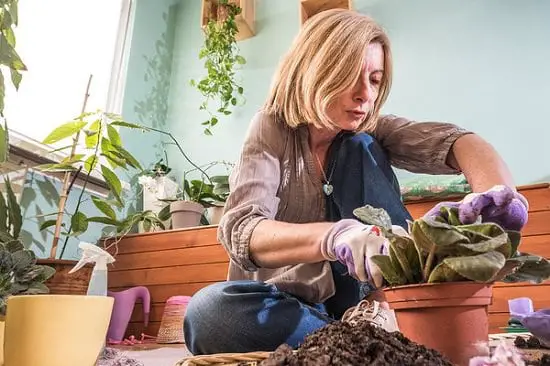Growing African Violet Indoors is more simple than you think! Follow these Plant Care tips for its optimum growth and maintenance!
African Violets have been one of the top choices as indoor plants for decades! With the right care and attention, Growing African Violet is easy! They also come in a wide range of flowers and types!
Check out some amazing purple flower plants here!
Size and Appearance

The range of flowers and color forms of African Violet are too many to choose from! Their sizes are divided under the following.
- Miniature, about 6 inches or less in diameter.
- Semi-miniature, 6-8 inches.
- Standard, 8-16 inches.
- Large, over 16 inches.
- Varieties of African Violet
Varieties of African Violet

African Violet comes in hundreds of varieties to choose from. Many Modern African Violets are a result of the hybridization of two species. Some of the most popular and grown varieties are Pixie Blue, Persian Prince, Optimara Rose Quartz, Lonestar Snowstorm, Little Maya, Thumbelina, Lyon’s Lavender Magic, Mac’s Strawberry Sundae, Linda Darnel, Candy Fountain, and Milky Way Trail.
How To Propagate African Violet?

African Violet can be grown through Leaf Cuttings or Seeds, in containers or pots.
Growing from Seeds
- As the seeds of African Violet are quite tiny, you will have to be a little extra careful while propagating.
- Start with a soil mixture comprising of Vermiculite, Peat, and Greensand.
- Add Epsom salt to the prepared mixture, as it helps to lighten the soil.
- Ensure that the temperature of the room stays between 18-24 C. It creates the right atmosphere for the growth of the seeds.
- Put the seeds at about 1 inch into the soil and cover them with a soil mix.
- Water, the pot till the soil, appears moist.
- The seeds will germinate in about 8 to 15 days.
Growing from Leaf Cuttings
- This is one of the most popular and used methods to grow African Violet.
- Start by cutting a healthy leaf with a stem from the plant, using a sterile knife or scissors.
- Trim the stem to one and a half inches.
- Dip the tip of the stem in a rooting hormone and put it in one inch deep in a pot filled with potting soil.
- Press the soil around the stem and water it.
- The roots will form in about 3 to 4 weeks, and the leaves will sprout in 6 to 8 weeks.
Choosing a Container
While growing miniature variety, choose a pot that is 5-6 inches deep. For growing a standard variety, go for a pot that’s at least 8-10 inches wide and deep. Containers made from clay, plastic, and ceramic is the best.
Requirements For Growing African Violet

Soil
The soil must be light, loose, and airy, and you can achieve the same by mixing peat moss, vermiculite, and perlite in equal ratios. Do make sure that you are repotting the African violets once in every six months in fresh soil, using the same pot.
Water
You have to take extra care when it comes to watering African Violets. Avoid spraying water on the foliage, and never let the soil dry out completely. Always water the plant from the base, when the soil starts to appear less moist.
Light
The plant requires the right mix of bright and indirect light to grow well. Plants with dark green foliage will need more light than plants with pale green foliage. Rotate the plant regularly to ensure every part is evenly exposed to the light. Place the growing plants near a south or west-facing window. You can also use fluorescent lights for an added supplement.
Fertilizer

There are many fertilizers available in the market for African Violets. Always go for the ones with higher phosphorus numbers, such as 15-30-15. Use it with one-quarter strength, every time you water the plant. If you notice dull leaf color and reduced flowering, then it is an indication that the plant needs fertilizer.
Pinching
Pinch away dead and spent flowers from the plant to encourage the growth of new flowers. This will also keep the plant looking healthy and green with its lush, shiny foliage.
Pests and Diseases
Cyclamen mites are the biggest enemy of African Violets, and there’s nothing much you could do once the mites attack the plant. Dispose of the affected plant to save others from mites. Also, be aware of Powdery Mildew, Rot, and Blight. Use recommended insecticide and keep the plant at an airy place.
A Quick look at African Violet Care Tips
- Always keep the soil lightly moist and never let it dry out completely.
- The leaves of the plant might rot in high humidity, so avoid spraying water on them.
- Fertilize the plant once every two weeks. Do not over-fertilize the plant.
- If you start to notice thin and leggy stems or light green and bleached leaves, then this is an indication of the plant getting too much light.
- Shift the plant to a large container as they grow. Repot only when you notice the leaves getting wilted.



very good submit, i actually love this website, carry on it
I love African Daisy , now I know what is the problem with the plant , also when and what kind of fertilizer to use… Thank you very much… !!
Thanks – Enjoyed this post, can you make it so I receive an email sent to me when there is a new update?